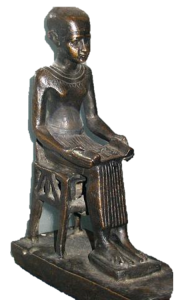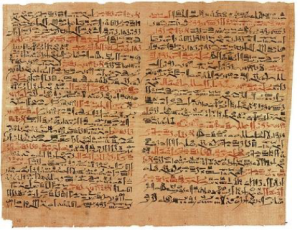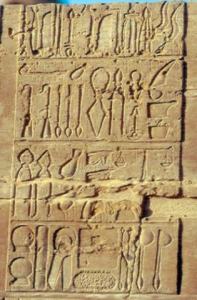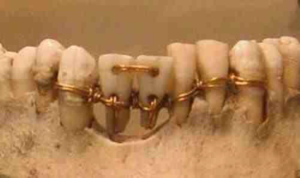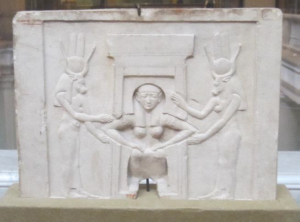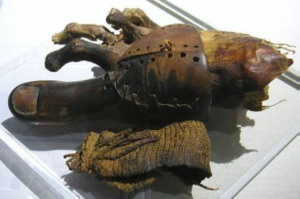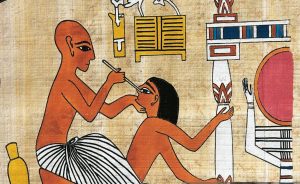Medicine in Ancient Egypt
Everything we know about medicine, surgery, and medical instruments can be traced back to the ancient Egyptians. The ancient Egyptians invented surgical instruments when other nations did not know how to treat wounds, heal the sick, or understand medical prescriptions. The ancient Egyptians produced medicine and performed surgeries that were unprecedented in the world. They taught the world medicine using plants and chemistry and knew surgical instruments from the simplest things. They reached a level of medical science that we have not yet been able to unravel its secrets, which is the science of mummification. The Greeks and Romans acknowledged this by deifying Imhotep, the skilled physician and brilliant engineer who built the step pyramid of King Djoser in Saqqara, and comparing him to their god Asclepius. The world believes that the letter “R” found in medical prescriptions is derived from the Greeks. However, the truth is that it is taken from the ancient Egyptians, as this letter “R” symbolizes the mouth, and it was through the mouth that the treatment was taken. In the medical tablet in Kom Ombo, we find a scene of a medical prescription where the letter “R” is written on it, and below it is the number of days of the week that the patient should take the medicine. The ancient Egyptians were also the first to know about anesthesia and used it in their surgeries. The anesthetic was made from certain plants. The ancient Egyptians also used metal and stone scalpels for surgery. They also knew about the sewing needle, thread, and sterilization. They performed brain surgeries when all the advanced civilizations today were living in caves. They also performed surgeries to fit artificial limbs. Today, women use ultrasound to determine the sex of the fetus. Did you know, dear reader, that the ancient Egyptians knew the sex of the fetus thousands of years ago? How? When an Egyptian woman felt pregnant and wanted to know the sex of the fetus, she would take two containers and put wheat grains in one and barley grains in the other. She would then add her urine to the containers. If the barley grew, they would know that the upcoming baby was a boy, and if the wheat grew, the baby would be a girl. Also, women in ancient Egypt did not give birth on beds but on birthing chairs. Modern science has proven that this method is the easiest way to give birth. There are many writings and papyri containing medical prescriptions, therapeutic drugs, and diagnoses of various diseases in all fields of medicine. The most important of these are the Ebers Papyrus, the Edwin Smith Papyrus, and the Chester Beatty Papyrus, which contain descriptions of medical treatments for many diseases and descriptions of some surgical procedures. There is no known science today that does not have a description in these papyri, even cancer itself.
Hesy-Ra
As Imhotep, the founder of medicine, is well-known for his great medical fame, Hesy-Ra, from the Old Kingdom era, is the first dentist. Many of his medical writings have been found in his tomb, there are also scenes of dental straightening, whitening, extraction, and implantation were found, which is considered an archive for dentistry. Among the ancient Egyptians, the god Thoth, the god of wisdom, was also considered the god of medicine because he restored the eye of the child god Horus, which had been gouged out by the god Seth. He also brought Horus back to life after Isis found him dead from a scorpion sting. According to the Osiris myth, Thoth assisted the gods Anubis and Horus in reassembling the body of the god Osiris. He also taught the goddess Isis the necessary incantations to revive her husband. The ancient Egyptians excelled not only in organic treatments but also in psychological and neurological treatments.
The Status of Physicians in Ancient Egypt
Physicians received specialized training in temples where the religious and ritual aspects played a significant role in the practice of medicine. When an ancient Egyptian physician performed a surgical operation on a king, prince, or high-ranking official, he would receive rewards, lands, and many gifts. The ancient Egyptians also knew about Viagra, i.e., sexual stimulants, from vegetables, especially lettuce, onion, watercress, and radishes. They also used “date pits” as a contraceptive to prevent ovulation, and it was known as a means of birth control and family planning. The treatment for all heart diseases and excelled in heart surgeries such as arterial surgeries are known. They also developed medical materials for treating the eyes. honey was used to treat burns by applying fatty substances to moisturize the skin. There were also medical prescriptions for treating baldness. Ancient Egyptians used onions as an anti-inflammatory and garlic to regulate blood pressure and treat coughs and indigestion.
The engineer Imhotep in the Louvre Museum in Paris
Edwin Smith Papyrus
A tablet of medical instruments from the Temple of Kom Ombo
Ancient Egyptian dental prosthesis from the National Museum in Baltimore
A birthing chair from temple of El Deir el-Bahri
An image of a wooden and leather prosthetic limb in the Egyptian Museum in Cairo


